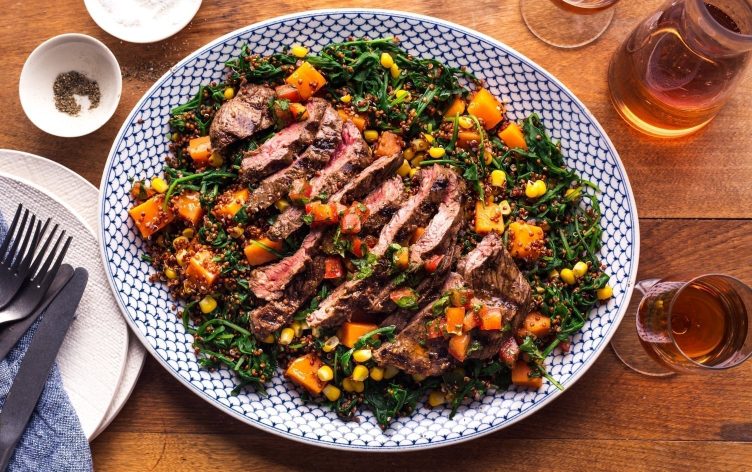
Yet another new diet is circulating gyms, and for once it’s not about losing weight — this one’s all about making gains.
The vertical diet was created by Stan “The Rhino” Efferding, an IFBB professional bodybuilder, for other bodybuilders and powerlifters. The name comes from the idea that the more training you do, the higher (or more vertical) your caloric needs.
The diet focuses on “highly bioavailable micronutrients” and “easily digestible macronutrients,” and claims to be based on optimizing gut health, correcting nutrient and hormone deficiencies, improving energy, stamina, endurance and recovery and building a sustainable lifestyle.
But, although the website says it’s also for weight loss, registered dietitians say it’s specifically for those in the bodybuilding world — not the average person going to the gym.
WHAT IS THE VERTICAL DIET?
The main staples of the diet are white rice and grass-fed red meat. These provide easily digestible carbs, iron, zinc, selenium and B vitamins. Other foods such as chicken, salmon, eggs and low-gas vegetables such as butternut squash, spinach, bell peppers, celery, parsley, zucchini, cucumber, carrots, eggplant and steamed potatoes are thought to cover your micronutrient needs.
The diet recommends avoiding high-starch carbohydrates such as wheat, beans, oats and brown rice as well as vegetable oils, garlic, sugar, coffee, vegetables high in the natural sugar raffinose (broccoli, asparagus, cauliflower) and alkaline water, which Efferding says raises pH and isn’t conducive to digestion.
WHY REGISTERED DIETITIANS ARE SKEPTICAL
“It’s refreshing to see a diet not demonizing carbs,” says Dana Angelo White, a certified athletic trainer and registered dietitian. “From a basic sports nutrition standpoint, carbs are really important. But I recommend a variety of carbs.”
Although she says white rice before a workout might be good since pre-workout is the time for easily digestible carbs, “some of the healthiest carbs are those highest in fiber,” she says. “White rice isn’t a bad food by any means, but you don’t want to get rid of more nutrient-dense carbs altogether.”
Variety also matters when it comes to protein. “I wouldn’t recommend more than 1–2 servings of lean cuts of red meat a week,” Dana Angelo White says. And although grass-fed beef tends to be more nutritious than corn-fed beef, not everyone likes the taste and it tends to be more expensive.
You may also lack micronutrients on this plan. “The vertical diet recommends restricting most vegetables as much as possible to avoid slowing down athletic performance, yet the MyPlate guidelines recommend at least 3 cups of vegetables per day for the average person and a variety of vegetables in order to meet all nutrient needs,” explains Jim White, RDN, an exercise physiologist and owner of Jim White Fitness and Nutrition Studios. Athletes and those training hard most likely have higher micronutrient needs and would benefit from more variety, he adds.
DEBUNKING SOME CLAIMS
“Overall, the vertical diet is a mere nutrition philosophy that does not include scientific evidence backing up any of its claims,” says Jim White.
People who find fiber hard to digest may experience better digestion, Dana Angelo White says, however, you’re eliminating nutrient-dense foods such as legumes. Plus, “some scientifically proven ways to improve gut health include eating a wide variety of foods; consuming a large amount of legumes, vegetables and fruit; consuming prebiotics from foods such as asparagus, onions and bananas; eating whole grains and eating a plant-based diet,” Jim White says. “The vertical diet restricts all of these.”
Claims the diet corrects nutrient and hormone deficiencies lack evidence and are confusing. “How do you know what people are deficient in? And what hormones are we talking about?” Dana Angelo White asks. “As this diet requires such a high level of restrictions from some of the most healthful foods, it’s most likely not correcting nutrient deficiencies but rather causing them,” Jim White adds.
Lastly, white rice may help improve energy and red meat may help with recovery. However, it’s unclear if this benefit would be strictly because of this combination of foods or more so because the diet is high in calories and “one of the biggest issues you see with athletes is that they under-fuel,” Dana Angelo White says.
THE BOTTOM LINE
The vertical diet cuts back on processed foods and is more balanced than some, but it’s too restrictive and too hard to follow for most people, Dana Angelo White says.
“For optimal performance results, nutrition should focus on two things: Everything in moderation and variety. Although all nutrients are great for the body, too much of anything is never a good thing,” Jim White adds. Whatever your goals, the vertical diet is most likely not the way to reach them.
